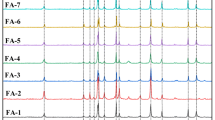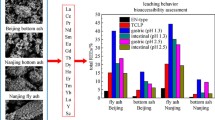Abstract
The aim of this study was to provide a comprehensive risk assessment for medical waste incineration fly ash from another aspect through various leaching methods. The differences and connections between leaching concentrations achieved via the toxicity characteristic leaching procedure (TCLP), the physiologically based extraction test (PBET) and the sequential extraction procedure were also described. Heavy metal contents of the used medical waste incineration fly ash were 1.7–31 times higher than that from Japan, indicating poor medical waste management in China. The fly ash leaching concentration in the TCLP test exceeded the regulation value and can be characterized as hazardous waste under current regulations. However, the PBET concentrations were only 1/10 of the TCLP value or even lower, and the calculated ingested contents of all heavy metals were lower than tolerable daily intake, demonstrating that TCLP might have overestimated the environment risk to some degree. The leaching metal content of TCLP ranged from exchangeable to residual forms, and the leaching percentage varied from 7.75 to 92.55 %, while the content for PBET was equal to or lower than the exchangeable form.





Similar content being viewed by others
References
State Council of China. State Council Order No. 308. Medical waste management regulations. Law Press, Beijing
Lombardi F, Mangialardi T, Piga L, Sirini P (1998) Mechanical and leaching properties of cement solidified hospital solid waste incinerator fly ash. Waste Manage 18:99–106
Sukandar S, Yasuda K, Tanaka M, Aoyama I (2006) Metals leachability from medical waste incinerator fly ash: a case study on particle size comparison. Environ Pollut 144:726–735
Environmental Protection Ministry of China. GB18598-2001. Standard for pollution control on the security landfill site for hazardous wastes. China Environmental Science Press, Beijing
Xue Q, Li J, Hu Z (2012) Compound stabilization/solidification of MSWI fly ash with trimercapto-s-triazine and cement. Water Sci Technol 66:689
Liu H, Zhang S, Zhang Y, Wei G (2010) Experiment on solidification of hospital waste incineration fly ash using cement. J Tianjin Univ 43:5
Munir Z (1988) Synthesis of high temperature materials by self-propagating combustion methods. Am Ceram Soc Bull 67:342–349
Cobo M, Gálvez A, Conesa JA, Montes de Correa C (2009) Characterization of fly ash from a hazardous waste incinerator in Medellin, Colombia. J Hazard Mater 168:1223–1232
Jang YC, Townsend TG (2003) Leaching of lead from computer printed wire boards and cathode ray tubes by municipal solid waste landfill leachates. Environ Sci Technol 37:4778–4784
Dou XB, Qi W, Xuan ZX, Hai JY (2005) Feasibility of different leaching procedures which can be used to identify toxicity characteristic of MSWI fly ash. Res Environ Sci 18:17–22
Environmental Protection Ministry of China. GB 16889-2008. Standard for pollution control on the landfill site of municipal solid waste. China Environmental Science Press, Beijing
Forbes AL, Arnaud M, Chichester C, Cook J, Harrison B, Hurrell R, Kahn S, Morris E, Tanner J, Whittaker P (1989) Comparison of in vitro, animal, and clinical determinations of iron bioavailability: international nutritional anemia consultative group task force report on iron bioavailability. Am J Clin Nutr 49:225–238
Luo X, Yu S, Li X (2012) The mobility, bioavailability, and human bioaccessibility of trace metals in urban soils of Hong Kong. Appl Geochem 27:995–1004
Chiang KY, Tsai CC, Wang KS (2009) Comparison of leaching characteristics of heavy metals in APC residue from an MSW incinerator using various extraction methods. Waste Manage (Oxford) 29:277–284
Sukandar S, Yasuda K, Tanaka M, Aoyama I (2006) Metals leachability from medical waste incinerator fly ash: a case study on particle size comparison. Environ Pollut 144:726–735
Sharma MC, Saxena R, Sharma SK, Singh S (2011) Modelling of heavy metal mobility in Delhi soils before and after remediation with green amendment rock phosphate using sequential extraction, TCLP and PBET. Asian J Water Environ Pollut 8:25–33
Karadaş C, Kara D (2012) Chemometric evaluation for the relation of BCR sequential extraction method and in vitro gastro-intestinal method for the assessment of metal bioavailability in contaminated soils in Turkey. Environ Sci Pollut Res 1–16
Chen J (2005) Study on the pyrolysis of medical waste. In: Thermal power engineering, Tianjin University, Tianjing
Ruby MV, Davis A, Schoof R, Eberle S, Sellstone CM (1996) Estimation of lead and arsenic bioavailability using a physiologically based extraction test. Environ Sci Technol 30:422–430
Tessier A, Campbell PGC, Bisson M (1979) Sequential extraction procedure for the speciation of particulate trace metals. Anal Chem 51:844–851
Fernández-Jiménez A, Palomo A (2005) Composition and microstructure of alkali activated fly ash binder: effect of the activator. Cem Concr Res 35:1984–1992
Ilic M, Cheeseman C, Sollars C, Knight J (2003) Mineralogy and microstructure of sintered lignite coal fly ash. Fuel 82:331–336
Shi HS, Kan LL (2009) Leaching behavior of heavy metals from municipal solid wastes incineration (MSWI) fly ash used in concrete. J Hazard Mater 164:750–754
Kuo HW, Shu SL, Wu CC, Lai JSH (1999) Characteristics of medical waste in Taiwan. Water Air Soil Pollut 114:413–421
Sun Y, Zheng J, Zou L, Liu Q, Zhu P, Qian G (2010) Reducing volatilization of heavy metals in phosphate-pretreated municipal solid waste incineration fly ash by forming pyromorphite-like minerals. Waste Manage 31:325–330
Van Herck P, Van der Bruggen B, Vogels G, Vandecasteele C (2000) Application of computer modelling to predict the leaching behaviour of heavy metals from MSWI fly ash and comparison with a sequential extraction method. Waste Manage (Oxford) 20:203–210
Davison RL, Natusch DFS, Wallace JR, Evans Jr CA (1974) Trace elements in fly ash. Dependence of concentration on particle size. Environ Sci Technol 8:1107–1113
Li R, Wang L, Yang T, Raninger B (2007) Investigation of MSWI fly ash melting characteristic by DSC–DTA. Waste Manage 27:1383–1392
Goodarzi F, Huggins FE (2001) Monitoring the species of arsenic, chromium and nickel in milled coal, bottom ash and fly ash from a pulverized coal-fired power plant in western Canada. J Environ Monit 3:1–6
Sterling R, Helble J (2003) Reaction of arsenic vapor species with fly ash compounds: kinetics and speciation of the reaction with calcium silicates. Chemosphere 51:1111–1119
Tolaymat T, Al-Abed S, Jegadeesan G (2009) Impact of bioreactor landfill leachate quality on As, Cd, Pb and Zn leaching from mine residues. Language 89:96
Liu F, Sun SX, Wang LX, Zhou DJ, Dai TY (2005) A comparison study on the leaching test methods used in hazardous waste identification. Res Environ Sci 18:23–26
Halim CE, Amal R, Beydoun D, Scott JA, Low G (2003) Evaluating the applicability of a modified toxicity characteristic leaching procedure (TCLP) for the classification of cementitious wastes containing lead and cadmium. J Hazard Mater 103:125–140
Van Herck P, Van der Bruggen B, Vogels G, Vandecasteele C (2000) Application of computer modelling to predict the leaching behaviour of heavy metals from MSWI fly ash and comparison with a sequential extraction method. Waste Manage 20:203–210
Karadaş C, Kara D (2011) In vitro gastro-intestinal method for the assessment of heavy metal bioavailability in contaminated soils. Environ Sci Pollut Res 18:620–628
Cui Y, Fu J, Chen X (2011) Speciation and bioaccessibility of lead and cadmium in soil treated with metal-enriched Indian mustard leaves. J Environ Sci 23:624–632
Henry W, Barbour R, Jakobsen R, Schumacher P (1982) Inorganic compound identification of fly ash emissions from municipal incinerators. NTIS, Springfield
Jung C, Matsuto T, Tanaka N (2005) Behavior of metals in ash melting and gasification-melting of municipal solid waste (MSW). Waste Manage (Oxford) 25:301–310
Davison RL, Natusch DFS, Wallace JR, Evans Jr CA (1974) Trace elements in fly ash. Dependence of concentration on particle size. Environ Sci Technol 8:1107–1113
Zielinski RA, Foster AL, Meeker GP, Brownfield IK (2007) Mode of occurrence of arsenic in feed coal and its derivative fly ash, Black Warrior Basin, Alabama. Fuel 86:560–572
Author information
Authors and Affiliations
Corresponding author
Rights and permissions
About this article
Cite this article
Xie, Y., Zhu, J. Leaching toxicity and heavy metal bioavailability of medical waste incineration fly ash. J Mater Cycles Waste Manag 15, 440–448 (2013). https://doi.org/10.1007/s10163-013-0133-x
Received:
Accepted:
Published:
Issue Date:
DOI: https://doi.org/10.1007/s10163-013-0133-x




